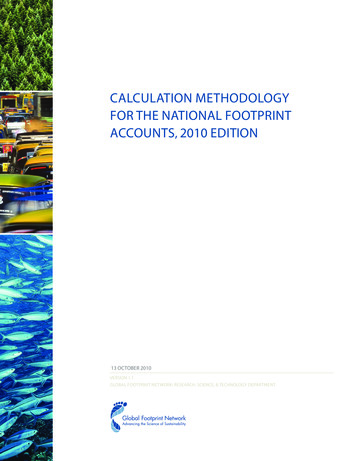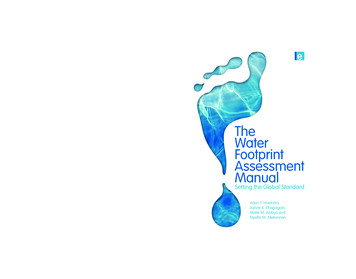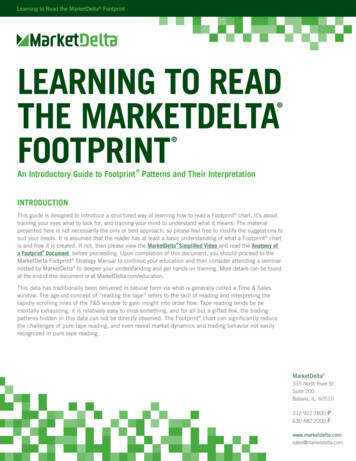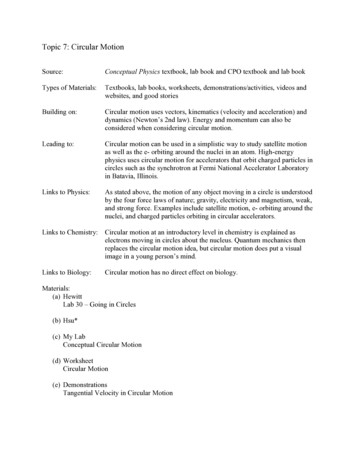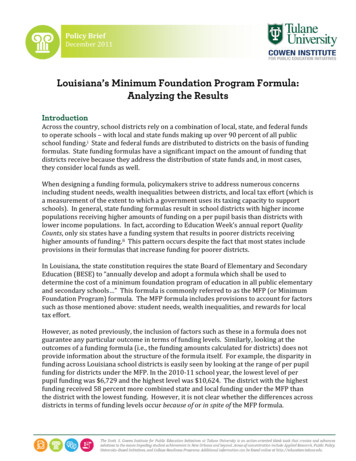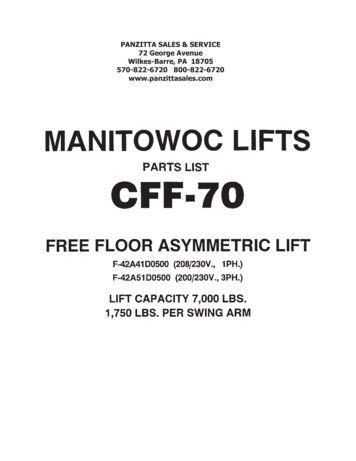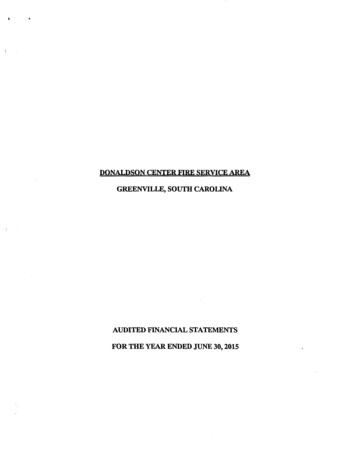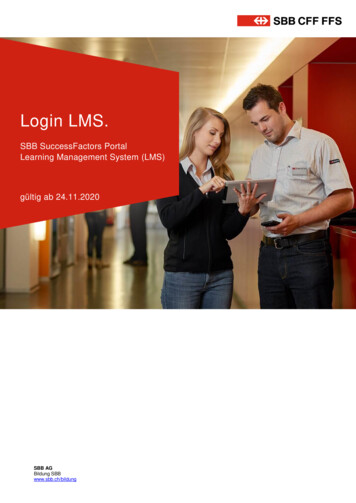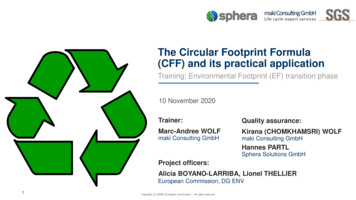
Transcription
The Circular Footprint Formula(CFF) and its practical applicationTraining; Environmental Footprint (EF) transition phase10 November 2020Trainer:Quality assurance:Marc-Andree WOLFKirana (CHOMKHAMSRI) WOLFmaki Consulting GmbHmaki Consulting GmbHHannes PARTLSphera Solutions GmbHProject officers:Alicia BOYANO-LARRIBA, Lionel THELLIEREuropean Commission, DG ENV1Copyright (c) (2020) European Commission – All rights reserved
Scope of training1. This training is directed primarily for Product Environmental FootprintCategory Rules / Organisation Environmental Footprint Sector Rules(PEFCR/OEFSR) development and EF-compliant data setdevelopment, both under the latest, transition phase PEF/OEF Method(„Suggestions for updating the Product Environmental Footprint (PEF)method”)2. It is also supporting the implementation of PEF/OEF studies undertransition phase PEFCRs/OEFSRs, developed under those rules3. Note for PEF/OEF studies or data sets that relate to preceding versionsof the PEF/OEF guide or are to be implemented underPEFCRs/OEFSRs developed during the pilot phase, that the CFF rulesslightly differ in some aspects2
Why the Circular Footprint Formula?Recycling and energy recovery, as well as using secondary materials andenergy leads to questions in EF work on how to account for benefits andburdens of these processes. For reproducibility and fairness, guidance isneeded: Where is the boundary between the first and the second product system? How should benefits and burdens of generating and of using recycledmaterial be shared between the first and the second product system? As generated secondary materials and energy carriers avoid primarymaterials and energy carriers being produced: how to select the specificprimary material and/or energy that is avoided? How to handle downcycling, i.e. differences in quality between secondarymaterial or energy and the primary material or energy? How to avoid double counting or gaps of benefits and burdens?4
Overview5
Circular Footprint Formula (CFF)Life Cycle Inventory(LCI) of primary materialLCI associated tosecondary material inputLCI of the material recycling (orpart/product reuse) process minusthe credit for avoided primary material LCI of the disposalof remaining waste6LCI of the energy recovery process minusthe credit for avoided primary energy
From secondary materials and energyinput and output essResources7Notes: Energy and consumables input, transport, storage and other activities are always included in the model, but graphicfocuses on core steps. Waste/ashes/slag from recycling and incineration are to be modelled to go to landfill (not shown).
. to connection with subsequent and precedinglife cycles via crediting and debiting .Primary debitfor usedsecondarymaterials ocessResources8SecondaryenergyEnergyproduction
. to abstraction and formularisation.Primary debitfor usedsecondarymaterials Qp 1Recyclingprocess(1-A) R2 ces9(1-B) *vPrim. energyproduction
The components of the CFF10
End-of-life: recycling and avoided primaryproduction; includes composting gprocessErecyclingEoL(1-A) R2 RecycledmaterialQSoutPrimaryproductionE*vQP 1Use11Life Cycle Inventory (LCI) of the materialrecycling (or part/product reuse) processminus the credit for avoided primary material
Point of substitutionRecyclingprocessErecyclingEoLUse(1-A) R2 RecycledmaterialQSoutPrimaryproductionE*vQP 1Point of substitution Necessary to be determined for the material part of the formula, i.e.what exactly is Ev and E*v (and to which point the recycling at EoL is tobe modelled) Point of substitution point in the value chain where the secondarymaterial substitutes primary material(s) Not always straightforward, e.g.: glass cullet vs. melted chinery-melting-131820/ steel scrap vs. secondary steel slab downcycled mixed polymers vs. fence/park bench (“open loop”)12
CFF: Factor “A”» The factor A allocates burdens and benefits from recycling and primary material productionbetween the two connected life cyclesA 0A 1In CFF: A 0.2, 0.5, or 0.8 . “A” is representing the market situation:o A 0.2: more high quality secondary material demanded than produced (e.g. many metals, glass, );indicator: market price is close to / same as primaryo A 0.8: the opposite is the case (e.g. textiles, ); indicator: market price is very low compared toprimaryo A 0.5: market situation is more balanced or unknown13
CFF: Quality ratios QSin/QP and QSout/QP Quality ratios QSin/QP and QSout/QP shall be determined at the point ofsubstitution per application or material and be based on:1. Economic aspects: i.e. price ratio of secondary compared toprimary materials at the point of substitution. In case the price ofsecondary materials is higher than that of the primary ones, thequality ratios shall be set equal to 1.2. When economic aspects are less relevant than physical aspects,the latter may be used. Accounts for quality of both ingoing and outgoing recycled materialso If Ev E*v, the two quality ratios are needed: QSin/QP associated to therecycled content, and QSout/QP associated to recycling at EoL - to capturedowncycling14o If Ev E*v, recycling to a different product (“open-loop recycling”), one qualityratio is needed: QSin/QP associated to the recycled content. QSout/QP isintegrated in E*v (via defining the equivalent functional unit) .
Recycled content – the credit-debit balanceamong connected life cyclesPrimary debitfor usedsecondarymaterials ialQp rialEvQsinARecyclingprocessErecycled15R1LCI of primary materialLCI associated tosecondary material input
End-of-life: waste-to-energy and avoided primaryproduction (plus analogous debit for secondaryenergy use)Avoidedprimaryproduction(“credit”)! “To avoid double-counting between the current and thesubsequent system in case of energy recovery, thesubsequent system shall model its own energy use asprimary cinerationUse16(1-B) R3SecondaryenergyPrim. energyproductionEERLCI of the energy recovery process burdensminus the credit for avoided primary energy
CFF: Factor “B” The factor B is used as an allocation factor between connected lifecycles for EoL energy recovery processes and generated secondaryenergy B is equal to 0 as default, i.e. 100% of generated, externally usedenergy is credited at the producer and debited at the user of thesecondary energy This also applies to waste fuels (e.g. of used rubber in cement kilns,but requires correct identification of point of substitution)17
End-of-life: landfilling (includes other EoLtreatment without product output)LCI of the disposalof remaining wasteUseLandfilling1-R2-R3EDNote that remaining waste after energy recovery is to be modelled as landfilled, in addition (unless used, e.g.as ash for cement making); EF waste-to-energy data sets consider this generally already.18
Circular Footprint Formula (CFF)Life Cycle Inventory(LCI) of primary materialLCI associated tosecondary material inputLCI of the material recycling (orpart/product reuse) process minusthe credit for avoided primary material ! Also used secondaryenergy / waste materials tobe modelled as replacedprimary energy (mix)! LCI of the disposalof remaining waste19LCI of the energy recovery process minusthe credit for avoided primary energy
List of variables and parameters of the CFFAllocation factor of burdens and benefits (jointly: “credits”) between supplier and user of recycled materials.Allocation factor of energy recovery processes. It applies both to burdens and benefits.Quality of the ingoing secondary material, i.e. the quality of the recycled material at the point of substitution.Quality of the outgoing secondary material, i.e. the quality of the recycled material at the point of substitution.Quality of the primary material, i.e. quality of the virgin material.Proportion of material in the input to the production that has been recycled from a previous system.Proportion of the material in the product that will be recycled (or reused) in a subsequent system. R2 shall therefore take intoaccount the inefficiencies in the collection and recycling (or reuse) processes. R2 shall be measured at the output of the recyclingplant.R3Proportion of the material in the product that is used for energy recovery at EoL.ErecycledSpecific emissions and resources consumed (per functional unit) arising from the recycling process of the recycled (reused)material, including collection, sorting and transportation process.ErecyclingEoLSpecific emissions and resources consumed (per functional unit) arising from the recycling process at EoL, including collection,sorting and transportation process.EvSpecific emissions and resources consumed (per functional unit) arising from the acquisition and pre-processing of virginmaterial.E*vSpecific emissions and resources consumed (per functional unit) arising from the acquisition and pre-processing of virginmaterial assumed to be substituted by recyclable materials.EERSpecific emissions and resources consumed (per functional unit) arising from the energy recovery process (e.g. incineration withenergy recovery, landfill with energy recovery, etc.).ESE,heat and ESE,elec Specific emissions and resources consumed (per functional unit) that would have arisen from the specific substituted energysource, heat and electricity respectively.EDSpecific emissions and resources consumed (per functional unit) arising from disposal of waste material at the EoL of theanalysed product, without energy recovery or other usable product output.XER,heat and XER,elec The efficiency of the energy recovery process for both heat and electricity.LHVLower heating value of the material in the product that is used for energy recovery.20ABQSinQSoutQPR1R2
Determining the values of theCFF variables and parameters21
CFF: Recycled content „R1“SituationSituation 1:The PEFCRProcess run by the company using thePEFCROptionMost relevant process Other processOption 1 the list of R1 values.Specific R1 valueshall prescribeOption 2Specific R1 valueDefault (applicationspecific) R1 valueSituation 2:Process not run by the company but withaccess to (company)-specific informationOption 1Supply-chain specific R1 valueOption 2Default (application-specific) R1 valueSituation 3:Process not run by the company and withoutaccess to specific informationOption 1Default (application-specific) R1 value Default values are given in Annex C of the PEF method document: Current version Annex C:https://eplca.jrc.ec.europa.eu/permalink/Annex C V2.1 May2020.xlsx rEF.xhtml for updates) For PEF studies on product groups and organisations for which a PEFCR is not available, and for commonrequirements on traceability and evidence needed, please see PEF method document p. 69 f22
CFF: Recycling output rate „R2“ The PEFCR shall list the default R2 values (i.e. as provided in Annex C of thePEF method) to be used when no company-specific values are available In case no company-specific R2 values are available, the Technical Secretariatof PEFCR selects and fixes either: R2 shall be equal to 0 Technical Secretariat generates new statistics to assign a new R2 value foruse in PEF studies; to be approved by the Commission23For PEF studies: Evaluate the recyclability of the material, provide evidence (see p. 72 of PEFmethod), use company-specific values if available If no company-specific values are available and the criteria for the evaluation ofrecyclability are fulfilled, application-specific R2 values from Annex C shall be used If an R2 value is not available for a specific country, then the European averageshall be used; If an R2 value is not available for a specific application, the R2 values of thematerial shall be used (e.g. materials’ average); In case no R2 values are available, R2 shall be set equal to 0 or new statisticsmay be generated in order to assign an R2 value in the specific situation.
Default values for CFF parameters Annex C Factor A (for sharing recycling burdens and benefits among connectedlife cycles); either “0.2”, “0.5” or “0.8” Factor B (for sharing energy recovery burdens and benefits amongconnected life cycles); always “0” QSin, QSout - downcycling factors for secondary materials Recycled content R1 Recycling rate R2 Shares of landfilling and of waste incineration per country and for EU2824
Example PET blister packagingas part of a PEF study on apackaged product25
Example PET blister packaging, 20 g PrimaryproductionEvPrimarymaterial1-R1QP cledR10.0442 kg CO2-eq (per 20 g PET)0.0133 kg CO2-eq (perRecycling20 g PET)Recycled(1-A) R21 (SSP high qual. recycledPET pellets)processmaterialQSout1ErecyclingEoL0.50.2 (company specific;default 0) SecondaryIncinerationUseenergy(1-B) R3EER𝟏 𝑹𝟏 𝑬𝒗 𝑹𝟏 𝒙 (𝑨𝑬𝒓𝒆𝒄𝒚𝒄𝒍𝒆𝒅 𝟏 𝑨𝑸𝑬𝒗 oductionE*vEnergyproductionEER 0.0411 kg CO2-eq
Example PET blister packaging, 20 g 1-R1270.0442 kg CO2-eq (per 20 g PET)Manufacturing0.0133 kg CO2-eq (per 20 g PET)Recycled1 material(SSP recycled PET pellets)R11QSin0.50.4 (company specific, default EoLQP 1E*vErecyclingEoLPrimaryQSoutproduction 1-AQPAR2(1-A) R2 ) R3LandfillingEdEnergyproductionEEREER𝟏 𝑨 𝑹𝟐 x (ErecyclingEoL- E*v1-R2-R3Secondaryenergy𝑸S𝒐𝒖𝒕)𝑸P 0.00618 kg CO2 eq
Example PET blister packaging, 20 g PrimaryproductionEvNo use of secondary energy inPET blister packagingPrimary1-Rmaterialproduction step, henceno debit 1on secondary energy. QP 1(1-A) facturingPrimaryproduction1-AEER plus creditsBR328Recycledmaterial1 (per 20 g PET)QSinCO2R0.0279 kg-eq00.27(1-B) R x (E - LHV x XRecyclingprocessErecycled3ER(1-B) ctionE*vPrim. energyproductionEERLandfilling1-R -REd23ER,heat x ESE,heat – LHV x XER,elec x ESE,elec) 0.00753 kg CO2-eq
Example PET blister packaging, 20 g PrimaryproductionEv(1-A) ss (1-B) R3materialx) 0 kg CO2eqproductionErecyclingEoLQSoutE*vQP cledmaterialQSinEDR2R3ErecycledR3R10.000680 kg CO2-eq (per 20 g PET)0.4 (company specific, default (1 - R2 - R3) x ED 0.000224 kg CO2-eqSecondaryenergyEnergyproduction
Example PET blister packaging, 20 g- 0.00618kg CO2-eq0.00753kg CO2-eqEv0.000224kg CO2-eqA0.0411 kg CO2-eq(jointly with primary PET) 0.0411 – 0.00618 0.00753 0.000224 0.0427 kg CO2-eq per 1 PET blister packaging from CFF calculation! The PEF study shall report all parameters and variable values used, the source and – if not default – provide evidence.30
Special cases31
How to apply the CFF to intermediate products Intermediate products -- cradle-to-gate PEF studies (e.g. metal sheets,flexible packaging, paper) The PEFCR shall prescribe the use of the CFF to exclude the end-of-life by setting R2, R3 and ED to 0 application- or material-specific A-values for the product, and to use and report results with two types of A values for the product in scope:o Setting A 1 in the PEF profile calculationo Setting A default value as listed in PEFCR to be used when creating EFcompliant datasets32
Example: metal sheets, as intermediate productMaterial part of CFF (i.e. energy and landfill part still to be added):𝑸𝑺𝒊𝒏𝑸𝟏 𝑹𝟏 𝑬𝒗 𝑹𝟏 𝒙 𝑨𝑬𝒓𝒆𝒄𝒚𝒄𝒍𝒆𝒅 𝟏 𝑨 𝑬𝒗 𝟏 𝑨 𝑹𝟐 x (ErecyclingEoL- E*v 𝑺𝒐𝒖𝒕)𝑸𝑷𝑸𝑷Metal sheets (steel) for building (from pilot phase):A 1 / 0.2; R1 0.54; R2 0; R3 0, QSin/QP 1; QSout/QP 1Setting A 1 in the PEF profile calculation:» 0.46Ev 0.54(Erecycled) 0Setting A default value (“0.2”) as listed in PEFCR to be used foradditional technical information and for creating EF-compliant data sets:» 0.46Ev 0.54(0.2Erecycled – 0.8Ev) 033
How to deal with specific aspects Recovery of bottom ashes or slag from incineration Landfill with energy recovery Municipal solid waste Compost and anaerobic digestion/ sewage treatment Waste materials used as fuel on input side Modelling complex products Extended product lifetime Reuse and refurbishment Reuse (e.g. of packaging)34For details, please see PEF method document, p. 74 ff
Questions & answersFurther questions: EF Helpdesk@thinkstep.com36
Exercise – wood-aluminium window frame37
Exercise/ Case studyProduct characteristics Wood-aluminium window with 165 mm frame depth, insulating glass 4mm flat glass inouter sash. Dimensions 1.23 x 1.48 m, weight 76.5 kg Lifetime 60 years Maintenance measures: gaskets replacement every 10 years, painting every 15 years,washing as needed Product standard EN 13163:2015 - Thermal insulation products for building Market: Denmark! For this training, we will focus on aluminium and wood frame, only.! Impacts will be calculated for Climate change (GWP), only.38
Exercise/ Case study - Material compositionMaterials/parts43.09 kg25.42 kg5.66 kg0.91 kg0.90 kg0.49 kg0.49 kgTotal3976.5 kg
Template to note down parameters and calculationMass ;R1 ; R2 ; R3 Climate change [kg CO2 eq] of EV,EV* A ; B 0; Qsin/Qp ; Erecycled ; ErecyclingEoL ; Qsout/Qp ; EER Ev A40 ; Ed
Materials for exercisePEF Method, i.e. Suggestions for updating the Product Environmental Footprint (PEF) method *Chapter 4 and Annex C4.4.8 End of life modellingUsers of the PEF method shall report all the parameters used. Default values for some parameters (A,R1, R2, R3 and Qs/Qp for packaging) are available in Annex C (see following sections for further details):users of the PEF method shall refer to the version of Annex C they are using. Annex C is available html.If a default value for R1 and R2 is not included in Annex C, users of the PEF method may providenew values to the Commission. Such values shall be part of a study that has been reviewed by anexternal independent third party reviewer. The Commission will take the decision if the new values areacceptable and can be implemented in an updated version of Annex C.* Zampori, L. and Pant, R., Suggestions for updating the Product Environmental Footprint (PEF) method, EUR 29682 EN, PublicationsOffice of the European Union, Luxembourg, 2019, ISBN 978-92-76- 00654-1, doi:10.2760/424613, JRC115959.41
Circular Footprint Formula (CFF)Life Cycle Inventory(LCI) of primary materialLCI associated tosecondary material inputLCI of the material recycling (orpart/product reuse) process minusthe credit for avoided primary material This environmental impact of incineration and creditsfor recovered energy is available as combined EFsecondary data set, per material (analogous as ED is acombined data set) – no need to manually calculate,usually LCI of the disposalof remaining waste42LCI of the energy recovery process minusthe credit for avoided primary energy
Materials for exerciseAR1R2 (Europe, post-consumer)! The company sources aluminium input with 20% recycled content R1 0.243
Materials for exercise44
Materials for exerciseAluminium EoL fate of un-recycled share:R3 (1-R2)*incineration share45R3 (1-0.9)*0.97 0.097
Materials for exerciseWood info on A, R1, R2, Qsin, Qsout: No recycled wood in wooden window fame profile (R1 0) No recycling at EoL, due to organic coating and fungicide treatment (R2 0) Hence, no need for factor A, i.e. all formula parts with parameter “A” are 0 Hence, also Qsin and Qsout are not required, for our example46
Materials for exerciseWood EoL routes1-R2-R3 (landfilling)R3 (waste incineration)R2 (recycling)Source: “Screening of EU and national policies, legislation and trends for EoL wooden doors and windows,2018”47
Material for exercise (Aluminium)Environmental footprint secondary data sets* to be used:Dataset nameUUIDEV and EV*: Climate change impact[kg CO2 eq.]per 1 kg product/serviceEU28 Aluminium ingot mixDD93261C-D6DA-44ECA842-78B4A42C28848.3Landfill of inert 7Recycling of aluminium intoaluminium scrap - from postconsumer **C4F3BFDE-C15F-4F7F8D35-BED6241704DB0.55Waste incineration of non-ferrometals, aluminium, more than 50µmFCA45061-A4D6-4665B583-8EC95C407FB50.12 **** Access to data sets via data nodes of data providers .xhtml), or distributed integrated inmajor LCA Software tools. Note use restrictions outside PEF/OEF studies under established PEFCRs/OEFSRs.** The data set name is misleading: This is melting of scrap into secondary aluminium slabs, while this includes some losses, as the dataset is not for clean scrap, so somewhat overestimates the impact.*** The metal is not oxidised/burned, i.e. does not generate any energy output that could be credited; recovery from Aluminium fromslag/ash not done in practice, hence no credit neither48
Material for exerciseEnvironmental footprint secondary data sets* to be used:Dataset nameUUIDEV and EV*: Climate change impact[kg CO2 eq]per 1 kg product/serviceSawn wood, softwood4BDF9A29-2AE8-49F4A92A-CDF7B668EBBE0.011DK Waste incineration ofprocessed woodA52AF3C9-08B7-48AB9309-74DA8356245D- 0.97 **Landfill of processed wood0907B969-C8A5-4317-84B304AD0A04447E1.8 *** Access to data sets via data nodes of data providers .xhtml), or distributed integrated inmajor LCA Software tools. Note use restrictions outside PEF/OEF studies under established PEFCRs/OEFSRs.** Including the credit (grid mix) for exported/used electricity and heat from energy recovery / landfill gas49
Excercise: 10161718132019141511127896245 Minutes remaining results30150
Aluminium (recycled content, EoL route shares)R1 0.2, R2 0.9, R3 0.097 1-0.2 0.8 0.9 0.097Ev 0.2A 1-0.9-0.097 0.003! The PEF study shall report all parameter and variable values used, the source and – if not default – provide evidence.51
Aluminium (mass recycled content, EoL routes)Aluminium mass 5.66 [kg] (1-0.2)*5.66 4.53 [kg] 0.9*5.66 5.09 [kg] 0.097*5.66 0.55 [kg]Ev 0.2*5.66 1.13 [kg]A 0.003*5.66 0.017 [kg]! The PEF study shall report all parameter and variable values used, the source and – if not default – provide evidence.52
Aluminium (GWP recycled content, EoL routes)A 0.2, Qsin/Qp 1, Qsout/Qp 1, B 0𝑸𝑺𝒐𝒖𝒕)𝑸𝑷 𝟏 𝑨 𝑹𝟐 x (ErecyclingEoL- E*v (1-0.2)*5.66*8.3 [kg CO2 eq] 37.60 [kg CO2 eq] (1-0.2)*0.9*5.66*(0.558.3*1) - 31.56 𝟏 𝑹𝟏 𝑬𝒗[kg CO2 eq] (1-0)*0.097*5.66*(0.12-0-0) 0.066 [kg CO2 eq 𝟏 𝑩 𝑹𝟑 x (EER – LHV x XER,heat x ESE,heat– LHV x XER,elec x ESE,elec)EvA (1-0.9-0.097)*5.66*0.027 0.00046[kg CO2 eq] 0.2*5.66*((0.2*0.55) (1-0.2)*8.3*1) [kg CO2 eq] 1.13*(0.11 6.64) 7.63 [kg CO2 eq] 𝑹𝟏 𝒙 𝑨𝑬𝒓𝒆𝒄𝒚𝒄𝒍𝒆𝒅 𝟏 𝑨 𝑬𝒗 𝟏 𝑹𝟐 𝑹𝟑 x ED𝑸𝑺𝒊𝒏𝑸𝑷 37.60 7.63 – 31.56 0.066 0.00046 13.74 [kg CO2-eq] per 1 window frame (contribution Aluminium part)53Note: disassembly, sorting, transport etc. not considered here for simplicity
Wood (recycled content, EoL route shares) 1-0 1 0 0.75EvA 0 0.25! The PEF study shall report all parameters and variable values used, the source and – if not default – provide evidence.54
Wood (mass material input, EoL routes)Wood mass 25.42 [kg] 25.42 [kg] 0 [kg] 19.06 [kg]EvA 0 [kg] 6.36 [kg]! The PEF study shall report all parameters and variable values used, the source and – if not default – provide evidence.55
Wood (GWP material input, EoL routes)There was an error in the original exercise calculations(0.11 instead of 0.011), which is now corrected here and inthe following steps). Please accept our apologies. 25.42*0.011 0.280 [kg CO2 eq]A 0.5, B 0𝑸𝑺𝒐𝒖𝒕)𝑸𝑷 𝟏 𝑨 𝑹𝟐 x (ErecyclingEoL- E*v (1-0.5)*0* 0 [kg CO2 eq] 𝟏 𝑹𝟏 𝑬𝒗 (1-0)*19.06*(0.97) - 18.49[kg CO2 eq] 𝟏 𝑩 𝑹𝟑 x (EER – LHV x XER,heat x ESE,heat– LHV x XER,elec x ESE,elec)EvA (1-0-0.75)*25.42*1.8 11.44 [kg CO2 eq] 𝟏 𝑹𝟐 𝑹𝟑 x ED 0* 0 [kg CO2 eq] 𝑹𝟏 𝒙 𝑨𝑬𝒓𝒆𝒄𝒚𝒄𝒍𝒆𝒅 𝟏 𝑨 𝑬𝒗𝑸𝑺𝒊𝒏𝑸𝑷 0.280 0 0 – 18.49 11.44 - 6.77 [kg CO2-eq] 1 window frame (contribution wood part) total (Aluminium and wood parts): 13.74 - 6.77 6.97 [kg CO2-eq]56Notes: Energy credit for used landfill gas included in landfilling dataset. Disassembly, sorting, transport etc. notconsidered here for simplicity.
Aspects not covered in the training exerciseThe following aspects and elements have not been explicit part of the exercise – pleaserefer to slides 6 to 35 for guidance:1. Open loop recycling (e.g. of wood to particle board)2. Landfill gas recovery (e.g. from wood in landfill; included in EF secondary datasets)3. Use of secondary energy or waste materials as energy input (e.g. waste wood or waste tires forindustrial heat production)4. Use of material/application combinations that are not (yet) part of Annex C5. Identifying the point of substitution6. Direct replacement of primary material or after mixing with secondary material7. Extended product lifetime, Reuse and refurbishment, Reuse (e.g. of packaging)8. Claiming / not claiming pre-consumer scrap input as recycled content9. CFF for intermediate products57
CFF in software modelsPEF/OEF studies are assumed to be implemented using software support:1. Specific EF software with a pre-configured model of the product system, e.g. implementing aPEFCR. Usually the formula will be integrated and the user exclusively needs to confirm orcorrect the parameters (A, R1, R2, ) for each material, or add them, in case any new materialsare used (as far as eligible within a PEFCR)2. Generic LCA software with CFF processes or models provided by the developers or to bedeveloped by the user, with specifics depending on the software. The parameters are to becompiled by the user (or taken from the PEFCR, if existing).58
Questions & answers onexerciseFurther questions: EF helpdesk@sphera.com59
Open Q&Q and discussionFurther questions: EF helpdesk@sphera.com60
Link Collection»Further reading about the EF transition phase»EF Wiki»Training calendar, access also to webinar and training recordings and slides»PEF method»OEF method»Description of governance bodies»Existing PEFCRs/OEFSRs, e-learning tools, and technical reports»Rules for EF compliant data sets»Email address technical helpdesk: EF helpdesk@sphera.com»Email address EF Team at DG ENV: env-environmental-footprint@ec.europa.eu61
Thank you for your interest and time!The contents of this training have been produced under service contract07.0203/2017/SI2.762537/SER/ENV.B.1 with the European Commission.The slides’ content has been approved by the Commission and represents the view of theCommission, while opinions expressed during the webinar are those of the contractors onlyand do not necessarily represent the EU’s official position.62Source: Marc-A. Wolf; freely usable under CC license
1. This training is directed primarily for Product Environmental Footprint Category Rules / Organisation Environmental Footprint Sector Rules (PEFCR/OEFSR) development and EF-compliant data set development, both under the latest, transition phase PEF/OEF Method („Suggestions for updating the Product Environmental Footprint (PEF) method") 2.


